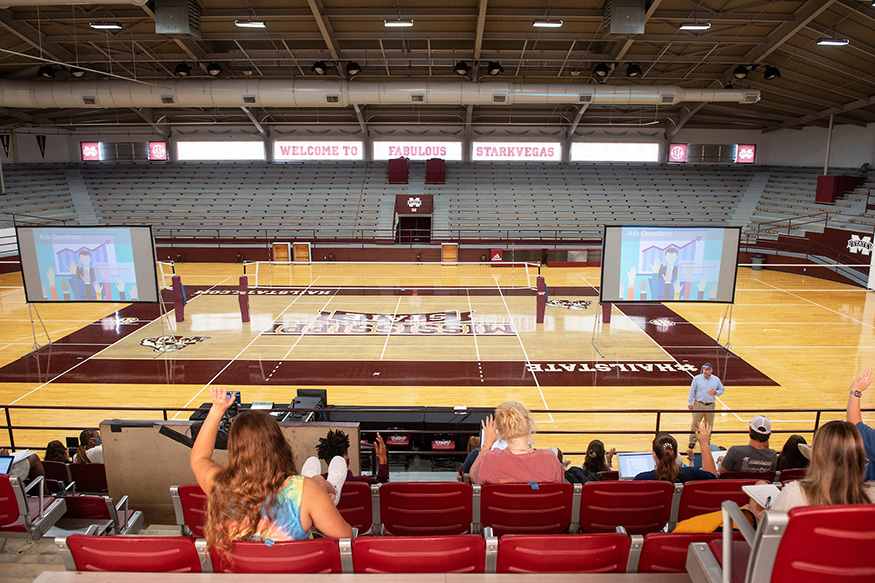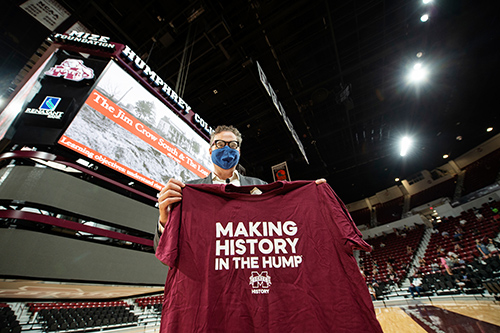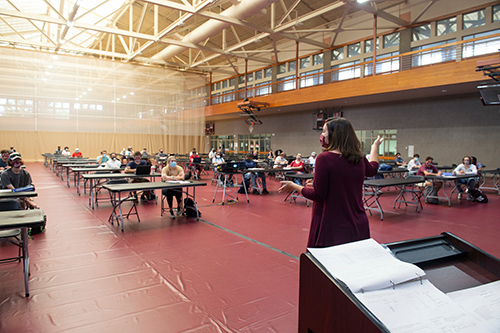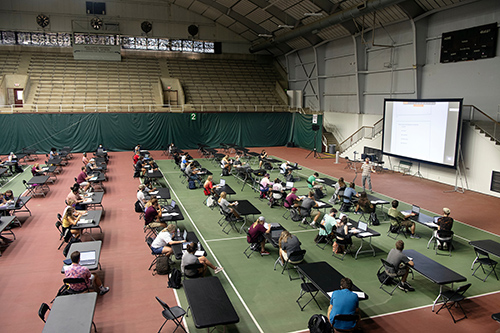‘Cast of thousands’ prepares MSU for semester experience like no other

Contact: MSU Office of Public Affairs

STARKVILLE, Miss.—The academic experience is looking a little different at Mississippi State this fall, especially from a row in the 10,500-seat Humphrey Coliseum where students are absorbing the fundamentals of U.S. history and political science during COVID-19 in the university’s largest indoor venue.
Turning “The Hump” into a 50%-capacity lecture hall didn’t happen overnight. In fact, it’s been a four-month process for MSU leaders to identify the larger campus spaces that could be transformed and outfitted with technology to allow not only for the necessary physical distancing, but for livestreaming, recording and uploading capabilities.
Other sizable venues now supporting academics for the first time in their history include the Sanderson Center’s recreational basketball gymnasiums, Newell-Grissom volleyball and McCarthy tennis gymnasiums, Colvard Student Union and Lee Hall’s Bettersworth Auditorium.
“When we began planning for the fall semester, we knew it would be unlike anything we have seen before on this campus,” MSU President Mark E. Keenum said. “I’m incredibly proud of the campus-wide effort these last few months to ensure that students can stay on their academic paths and have the option of a safe, in-person college experience. There have been many challenges and undoubtedly more will arise, but I thank everyone who has had a role in getting us where we are today. I especially want to thank our faculty who continue to provide world-class instruction to students, through multiple delivery methods, despite the many obstacles presented by this pandemic.”
After an appointed nontraditional classroom task force pinpointed additional spaces, the scheduling team in the Office of the Registrar assessed each one of the 15 selected alternative spaces and worked with the eight academic colleges to completely rebuild the master class schedule, according to John Dickerson, assistant vice president for enrollment and university registrar.
“This was a team effort,” Dickerson said, praising offices such as that of the Provost and Executive Vice President, Information Technology Services, Facilities Management, Custodial Services, Event Services, the Division of Athletics and the Center for Teaching and Learning.
“ITS was key in determining the appropriate technology needed, procuring it and getting it installed in a very short amount of time,” he said, adding that this office also proved indispensable in providing data that helped in making sound decisions.
Pulling 29,000 Feet of Cable

Outfitting classrooms with the tools faculty need for instruction, such as computers, projectors and microphones is routine for ITS, but the pandemic has brought on significant additional technology needs.
For the nontraditional classroom spaces, ITS designed portable “PODs” that contain the technology required to connect with a variety of systems. ITS also ordered cameras to outfit 154 ITS-supported classrooms for livestreaming and lecture recording. In the meantime, crews pulled approximately 29,000 feet of network cable to ready the spaces, but supply chain issues and global demand delayed the arrival of the cameras and other key equipment until just a few days prior to the start of classes on Aug. 17. ITS personnel worked around the clock on the installations to be ready for the first day of the semester.
“The effort and commitment of ITS personnel to get all the equipment deployed over the course of a weekend was truly amazing to witness,” said MSU Chief Information Officer Steve Parrott. “Multiple ITS teams worked relentlessly to ensure the technology would be available and functional for that first day of classes. Event Services provided wonderful assistance to ITS in some of the nontraditional classroom spaces. In addition, Athletics assisted with nontraditional classroom spaces in its venues. I couldn’t be prouder of all who were involved to make such a widespread successful classroom technology deployment.”
With the technology in place, a group of student volunteers from several campus organizations were trained on the equipment one day before classes began. These volunteers were then assigned to different classrooms, where they have been assisting faculty with troubleshooting any issues that arise. Student volunteers represent groups that include Alumni Delegates, Foundation Ambassadors, Orientation Leaders, Roadrunners, S.P.A.R.K., and College of Arts and Sciences Ambassadors, as well as information technology services majors.
Sanitizing 600 Class Spaces
MSU administrators, faculty and staff had to tackle the daunting challenges brought about by educating thousands of students during COVID-19 while adhering to numerous health and safety protocols.
Vice President for Finance and Administration Don Zant said there has been a series of what he labeled as “monumental” tasks undertaken, decisions to be made and milestones to accomplish throughout the pandemic.
“We did a lot of research. Since this challenge was impacting everyone, we pulled knowledge and expertise from a much larger base,” Zant said. “It has indeed been a cast of thousands.”
Regarding the financial repercussions, Zant said Mississippi State is fortunate to be in a strong fiscal position to weather the storm, and the finance team is working diligently to adhere to federal and state requirements for CARES Act funding.

“We have put many hours into making sure we identify, prioritize and properly document where the CARES Act funding can be used,” Zant said.
From a facilities standpoint, Zant said the teamwork across campus to allocate how spaces could best be utilized in the midst of social distancing requirements “is another great example of everyone pitching in and sacrificing in their own areas to instead look out for the university’s overall best interest.”
In Campus Services, which houses Custodial Services, one obstacle Zant said had to be overcome was “figuring out how some 120 custodians could complete their normal responsibilities while also sanitizing about 600 learning spaces. To accomplish this, we had one of our Financial Analysts work with the Registrar’s Office to schedule every class to coordinate the times in between when classrooms would be available to clean,” Zant said.
“All told, there are somewhere between 2,500 and 3,200 individual learning space sanitizations happening daily. It is hard to pick out one example of someone going the extra mile because almost everyone is doing this,” he said.
MSU innovation and can-do attitude helped address the shortage of needed supplies, such as disinfecting wipes.
“Very early on, sanitizing wipes became almost impossible to purchase in large quantities. But thinking outside the box, Campus Services found they could get all the components—absorbent paper, containers and sanitizing liquid—and put them together, and even made stands for the sanitizer containers. Through these extraordinary efforts, we now have sanitizing wipes in every classroom for faculty and student use,” Zant said.
Helping Faculty with Resources
MSU Executive Vice Provost Peter Ryan said everyone on campus, from students to faculty to staff, has a role to play in curtailing the spread of COVID-19. He praised Facilities Management, the Longest Student Health Center and the Registrar’s Office as a few of the many units who have “gone above and beyond” to ensure a safe learning and working environment for all.
“The president, provost, vice presidents and members of the COVID-19 Task Force have done incredible work in communicating with the campus community, and our faculty are continuing to provide our students the best educational experience possible through in-person and other modes of instruction,” he said. “ITS, the CTL and the Center for Distance Education also have been instrumental in providing training sessions and videos to help faculty with new classroom technology and those who needed to pivot to online delivery of their courses.”
Susan Seal, CDE executive director, said the center’s technology staff has conducted numerous one-on-one and departmental trainings since spring break. Many of these sessions have been recorded and archived.
“We have developed two templates for colleges and departments and have several others in the works that will assist faculty in course development to ensure strong instructional design, access and ADA compliance,” she said. “The templates also will provide consistency to the look and feel of courses within a program, making it easier for students to navigate online courses.”
Seal said with support from the Provost’s Office, staff in CDE, CTL, ITS and Mitchell Memorial Library have worked together to develop an Instructional Resource Guide website for faculty.
“This site is a one-stop-shop where faculty can find resources for teaching online, regardless of which unit developed the resources,” she said. “We are also in the process of hiring two instructional designers to support faculty with the development and design of online courses.”
Dana Morin, an assistant professor in the College of Forest Resources’ Department of Wildlife, Fisheries and Aquaculture, said teaching during the pandemic is a daunting challenge, especially because of the numerous adaptions needed for many course designs.
“I create a couple game plans each week to be prepared and try to incorporate some flexibility,” she said of her courses. “I had been interested in experimenting more with a flipped classroom approach for the course I teach, and the hybrid format gave me the push to commit,” she said, explaining her asynchronous unit in Canvas and synchronous WebEx discussion group, among other teaching formats. “I will probably try to incorporate some of those successful elements in future semesters.”
Morin described a feeling of camaraderie with students and colleagues over the common challenges this semester.
“Every week, after the relief and excitement of the first week, has brought new challenges but has also been another reward—another demonstration of the commitment of the faculty, students and community to be here. That’s a pretty extraordinary experience. I hope we can keep it going,” she said.
MSU is Mississippi’s leading university, available online at www.msstate.edu.